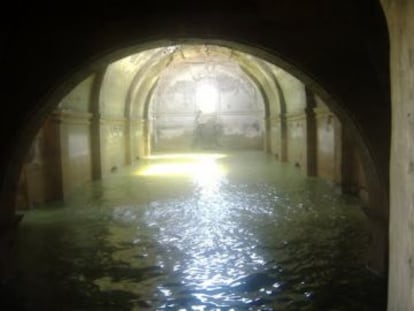Low water levels reveal submerged 16th-century temple in Mexico
The historic Dominican structure only surfaces during times of drought


When a temple emerges in Jalapa del Marqués, the people know difficult days lay ahead. The 16th-century Dominican structure only surfaces during drought years, which means less fishing and smaller harvests for this small Oaxaca town, located deep in the south of the country. It also means more hunger.
The temple, a beautiful compound that includes a church, a convent and a bell tower, has emerged as water levels drop in the Benito Juárez Dam at the confluence of the Tehuantepec and Tequisistlán rivers.
Hundreds of fishermen who depend on its waters for their livelihood have had to pick up work as tour guides
In 1962, the 947-hectometer dam flooded Jalapa Viejo, the town where the temple is located. Since then, the structure has emerged three times, always during extremely dry seasons. The building was last seen in 2006.
The dam is 40% full and the 247 communities in the Tehuantepec Isthmus have become concerned about possible water shortages. Hundreds of fishermen who depend on its waters for their livelihood have had to pick up work as tour guides, ferrying tourists to the temple in their small boats.

The religious structure was one of the main missionary centers in Oaxaca in the 16th century and it remained active until its expropriation in 1859, when it passed into government hands. Although the waters have damaged its domes, cross and bell tower, the elegance of its structures is still astounding.
In October, another 16th-century Dominican temple surfaced in the Malpaso Dam in Quechula, Chiapas.
English version by Dyane Jean François.
Tu suscripción se está usando en otro dispositivo
¿Quieres añadir otro usuario a tu suscripción?
Si continúas leyendo en este dispositivo, no se podrá leer en el otro.
FlechaTu suscripción se está usando en otro dispositivo y solo puedes acceder a EL PAÍS desde un dispositivo a la vez.
Si quieres compartir tu cuenta, cambia tu suscripción a la modalidad Premium, así podrás añadir otro usuario. Cada uno accederá con su propia cuenta de email, lo que os permitirá personalizar vuestra experiencia en EL PAÍS.
¿Tienes una suscripción de empresa? Accede aquí para contratar más cuentas.
En el caso de no saber quién está usando tu cuenta, te recomendamos cambiar tu contraseña aquí.
Si decides continuar compartiendo tu cuenta, este mensaje se mostrará en tu dispositivo y en el de la otra persona que está usando tu cuenta de forma indefinida, afectando a tu experiencia de lectura. Puedes consultar aquí los términos y condiciones de la suscripción digital.
Últimas noticias
Reinhard Genzel, Nobel laureate in physics: ‘One-minute videos will never give you the truth’
Pinochet’s victims grapple with José Antonio Kast’s rise in Chile
How Japan is trying to avert ‘digital defeat’
The complicated life of Francesca Albanese: A rising figure in Italy but barred from every bank by Trump’s sanctions
Most viewed
- Pablo Escobar’s hippos: A serious environmental problem, 40 years on
- Why we lost the habit of sleeping in two segments and how that changed our sense of time
- Trump’s obsession with putting his name on everything is unprecedented in the United States
- Charles Dubouloz, mountaineering star, retires at 36 with a farewell tour inspired by Walter Bonatti
- The Florida Keys tourist paradise is besieged by immigration agents: ‘We’ve never seen anything like this’








































